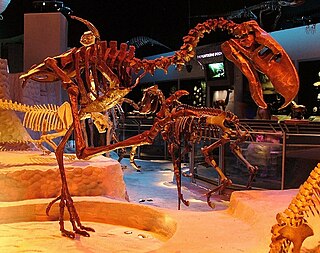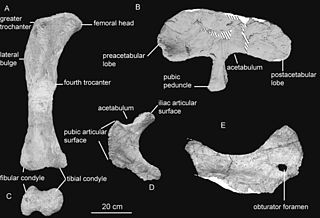
Anseriformes is an order of birds also known as waterfowl that comprises about 180 living species of birds in three families: Anhimidae, Anseranatidae, and Anatidae, the largest family, which includes over 170 species of waterfowl, among them the ducks, geese, and swans. Most modern species in the order are highly adapted for an aquatic existence at the water surface. With the exception of screamers, males have penises, a trait that has been lost in the Neoaves, the clade consisting of all other modern birds except the galliformes and paleognaths. Due to their aquatic nature, most species are web-footed.

The Orinoco goose is a Near Threatened species of waterfowl in the tribe Tadornini of subfamily Anserinae. It is found in every mainland South American country except Chile, French Guiana, Suriname, and Uruguay.

Neochen is a genus of birds in the family Anatidae.

Phorusrhacids, colloquially known as terror birds, are an extinct family of large carnivorous, mostly flightless birds that were among the largest apex predators in South America during the Cenozoic era. Their definitive fossil records range from the Middle Eocene to the Late Pleistocene around 43 to 0.1 million years ago, though some specimens suggest that they were present since the Early Eocene.

Chloephaga is a genus of sheldgeese in the family Anatidae. Other sheldgeese are found in the genera Alopochen and Neochen.

Rocasaurus is a genus of titanosaurian sauropod that lived in South America. Rocasaurus was discovered in Argentina in 2000, within the Allen Formation which is dated to be middle Campanian to early Maastrichtian in age. This genus grew up to 8 metres (26 ft) long, making it one of the smaller sauropods. It seems to be closely related to saltasaurid dinosaurs, like Saltasaurus and Neuquensaurus.

Brontornis is an extinct genus of giant bird that inhabited Argentina during the Early to Middle Miocene. Its taxonomic position is highly controversial, with authors alternatively considering it to be a cariamiform, typically a phorusrhacid or an anserimorph.
Victorlemoinea is an extinct litoptern genus of the family Sparnotheriodontidae, that lived from the Early to Middle Eocene. Fossils of Victorlemoinea have been found in the Las Flores, Sarmiento and Koluel Kaike Formations of Argentina, the Itaboraí Formation of Brazil and La Meseta Formation, Antarctica.
Physornis is an extinct genus of giant flightless predatory birds of the family Phorusrhacidae or "terror birds", most closely related to Paraphysornis, that lived in Argentina. The type species is P. fortis. It lived during the Middle to Late Oligocene (Deseadan). Few fossils are known, but the available material suggests that Physornis was one of the largest phorusrhacids.

Patagornis is a genus of extinct flightless predatory birds of the family Phorusrhacidae. Known as "terror birds", these lived in what is now Argentina during the Early and Middle Miocene; the Santa Cruz Formation in Patagonia contains numerous specimens. Patagornis was an agile, medium sized Patagornithine and was likely a pursuit predator.
Cruschedula is an enigmatic bird genus considered to be nomen dubium which consists of the single species Cruschedula revola.

Necrolestes is an extinct genus of mammals, which lived during the Early Miocene in what is now Argentine Patagonia. It is the most recent known genus of Meridiolestida, an extinct group of mammals more closely related to therians than to monotremes, which were the dominant mammals in South America during the Late Cretaceous. It contains two species, N. patagonensis and N. mirabilis; the type species N. patagonensis was named by Florentino Ameghino in 1891 based on remains found by his brother, Carlos Ameghino in Patagonia. Fossils of Necrolestes have been found in the Sarmiento and Santa Cruz Formations. Its morphology suggests that it was a digging, subterranean-dwelling mole-like mammal that fed on invertebrates.
Neochen pugil is an extinct species of goose from the Late Pleistocene or possibly the Early Holocene of Brazil. The fossils were discovered by Danish paleontologist Peter Wilhelm Lund near Lagoa Santa, Minas Gerais state, and described by Danish ornithologist Oluf Winge in 1888. It was related to the living Orinoco goose, but much larger.
Neochen barbadiana is an extinct species of goose from the Late Pleistocene of Barbados. The species was described by American paleontologist Pierce Brodkorb from fossils found in Ragged Point, Saint Philip. This was the third fossil species of the genus to be described after Neochen pugil and N. debilis from Brazil and Argentina, respectively.
Thegornis is an extinct genus of herpetotherine falconid that lived during the Miocene of South America. The genus was erected by Florentino Ameghino in 1895 based on two species, T. musculosus and T. debilis. However, T. debilis was later suggested to be an invalid species, with the differences between it and T. musculosus being due to sexual dimorphism. Two additional species, T. spivacowi and T. sosae, were subsequently named in later years by Federico Agnolín. Its skull and postcranial morphology are similar to the laughing falcon and forest falcon, which together form the clade Herpetotherinae. The seriema Noriegavis's holotype was transferred to this genus and the well-preserved specimen described in 2015 attributed to Noriegavis has been classified into Miocariama.
Proadinotherium is an extinct genus of toxodontid. It lived between the Late Oligocene and the Early Miocene in what is now South America.
Colpodon is an extinct genus of herbivorous mammal, belonging to the order Notoungulata. It lived during the Early Miocene, in what is today Argentina and Chile, in South America.

Cochlops is an extinct genus of glyptodont. It lived from the Early to Middle Miocene, and its fossilized remains have been found in South America.








